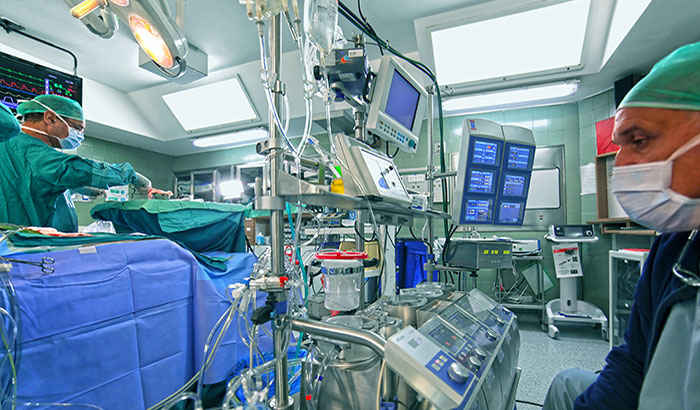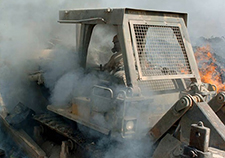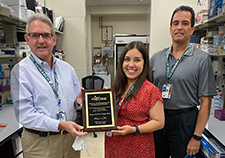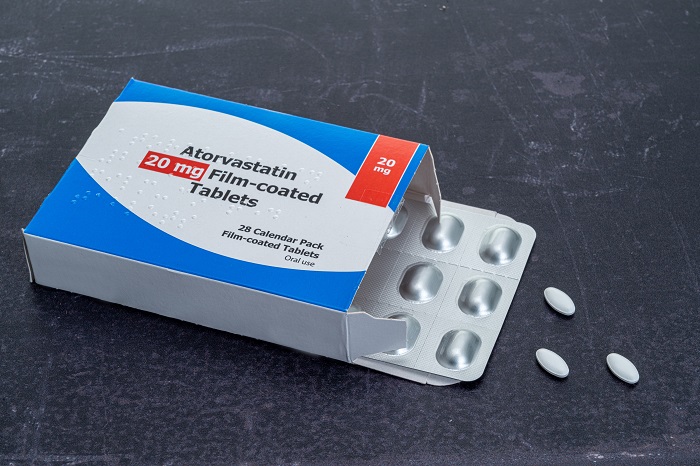Office of Research & Development |
 |
Office of Research & Development |
 |


VA researchers sought to learn whether drug-eluting or bare-metal stents are more effective in addressing first-time saphenous vein graft lesions, a blockage in blood vessels that can occur after bypass surgery. (Photo: ©iStock/Alexey_ds)
May 16, 2018
By Mike Richman
VA Research Communications
A new study finds that two kinds of stents often used in patients who have heart bypass surgery are equally effective in preventing heart attacks, cardiac death, and repeat procedures to the arteries of the heart.
Researchers compared bare metal stents (BMSs) with drug-eluting stents (DESs). Both are mesh tubes of thin wire, the difference being that DESs are coated with a drug. They are commonly used to open blocked blood vessels that can develop after a patient undergoes heart bypass surgery.
"Using mainly second-generation drug-eluting stents in DIVA makes it the most relevant study for contemporary medical practice."
Bypass surgery is meant to treat a narrowing of the coronary arteries of the heart by restoring normal blood flow.
The main endpoint in the VA-funded study, which appeared in the journal The Lancet in May 2018, was the rate of target vessel failure 12 months after the procedure. Target vessel failure is the combination of a heart attack, the need for another surgical procedure to restore blood circulation to the heart, or cardiac death.
The nearly 600 Veterans in the study were randomly divided into the two stent groups. Neither the patients nor the investigating team knew who was in which group.
The researchers found no major differences between the patients using the two types of stents.
The 12-month rate of target vessel failure was 19 percent in the BMS group and 17 percent in the DES group. The rate of target vessel failure for the full length of time the patients were followed, which averaged nearly three years, was 34 percent in the BMS group and 37 percent in the DES group.
Dr. Emmanouil Brilakis, a heart disease specialist at the VA North Texas Health Care System, led the study, known as the “DIVA trial.” It was funded by VA’s Cooperative Studies Program. The trail aimed to learn whether drug-eluting stents or bare-metal stents are more effective in addressing first-time saphenous vein graft (SVG) lesions, an obstruction in blood vessels that can occur after bypass surgery.
Brilakis and his team were surprised to find no major differences between the two stent groups. The common belief in the medical community is that patients with SVG lesions benefit more from drug-eluting stents than from bare-metal stents. Although research has shown that drug-eluting stents improve outcomes compared with bare-metal stents in coronary artery lesions, their effectiveness and safety in treating SVG lesions has received limited study.

VA Study Documents Health Risks for Burn Pit Exposures

VA center training the next generation of researchers in blood clots and inflammation

Could cholesterol medicine reduce dementia risk in seniors?

Million Veteran Program director speaks at international forum
“We were anticipating that DESs would be superior to BMSs, based on what has been shown for many other types of coronary lesions,” Brilakis says. “But two main factors likely explain our findings. First, we know that SVG atherosclerosis is different than coronary artery atherosclerosis,” which is when the arteries become hardened and narrow because of a plaque buildup around the artery wall.
"The medications used in drug-eluting stents may not work as well in saphenous vein grafts possibly because the process that leads to blockages in vein grafts is different than the process in coronary arteries," he says. "Also, bypass graft patients are likely to be older and have many other medical problems, all of which increases their likelihood of heart attack or death.
Cardiovascular disease, the No. 1 killer of Americans, is the leading cause of hospitalization in VA. The disease is associated with ailments that often affect Veterans, including diabetes, PTSD, and spinal cord injuries.
One of the most common forms of heart disease, coronary artery disease, is an obstruction of the vessels that supply blood to the heart. Coronary artery disease is a key reason people have bypass surgery in hopes of avoiding a heart attack or death. In heart bypass surgery, grafts are put between the aorta and the heart to open up the blockages.
Grafts using the saphenous vein, which runs in the leg, have long been used in heart bypass surgery to route the blood around an artery lesion. But these grafts often develop atherosclerosis.
Using a stent to unblock a blood vessel, especially a coronary artery, is an alternative to repeat bypass surgery. A second operation can result in higher rates of sickness and death.
Bare-metal stents appeared in the late 1980s and early 1990s as an enhancement to balloon procedures. Previously, doctors would inflate a balloon within the blockage to clear it and send the patient on his or her way, in hopes the cleared artery would remain open. Through the use of stents, doctors now had a scaffold to keep the artery open.
BMSs were the primary means of stenting until DESs came on the market about 15 years ago. Doctors now rely on second-generation DESs, which have new polymers and drugs that are less likely to cause long-term problems.
Despite costing about $2,000 more per patient than BMSs, drug-eluting stents are often preferred over bare-metal stents because DESs carry a lower risk of restenosis, a growth of tissue into the stent that results in vessel narrowing. Drug-eluting stents are placed into narrowed, diseased coronary arteries. They release a drug to block a rapid increase of cells. This prevents fribrosis, which, together with clots, can block the stented artery.
The published paper on the DIVA trial notes that in three of the four previous randomized studies on saphenous vein graft lesions, drug-eluting stents appeared to provide improved outcomes compared with bare-metal stents. The results were based on the lower rates of surgery to restore blood circulation to an organ or area following use of DESs.
Those studies, Brilakis says, were generally limited by several factors: small size, lack of blinding, use of routine angiographic follow-up and first-generation DESs, and low use of embolic protection devices, which guard against heart attacks during the procedure. Angiography is a medical imaging technique used to see the inside of blood vessels or organs in the body, with a special focus on the arteries, veins, and heart chambers.
Brilakis explains that an important advantage in the methodology of the DIVA trial—compared with the other studies—is that it didn’t require a routine angiographic follow-up. That “makes our result more robust,” he says, noting that angiography can bias the results in favor of drug-eluting stents because of their lower rates of restenosis.
The DIVA trial also avoided other limitations in the studies mentioned in the DIVA paper, according to Brilakis. He says DIVA was large, with nearly 600 patients; had high rates of embolic protection device use; included a blinding of patients and doctors; and used mainly second-generation DESs, the current standard of care, he says.
“Second-generation DESs have been shown to have better outcomes than first-generation, with less stent thrombosis, fewer heart attacks, and less restenosis,” he says. “Using mainly second-generation drug-eluting stents in DIVA makes it the most relevant study for contemporary medical practice.”
Stent thrombosis is the sudden blockage or closure of a stented coronary artery, an occurrence that can lead to heart attack or death.
In terms of a lack of blinding, Brilakis says, the patient outcomes and the assessment of those outcomes by the doctors may be affected by knowledge of where the patient is randomized. For example, he says, “Patients who were known to receive BMSs may be more likely to undergo a repeat procedure to treat a heart condition if they had symptoms, even atypical ones. Doctors could consider those patients `higher risk’ because they had received BMSs.”
A study nearly identical to the DIVA trial in the number of patients, the Germany-based ISAR-CABG trial, showed initial benefit with drug-eluting stents that was based on a 12-month follow-up. But researchers in that trial found no major difference between drug-eluting and bare-metal stents in the long-term follow-up that was published in May 2018 in the Journal of the American College of Cardiology.
The ISAR-CABG trial was not blinded and included angiography.
The 597 patients in the DIVA Trial were randomized into the BMS and DES stent groups at 25 VA medical centers. The patients averaged 69 in age and all but two were men.
Brilakis says about 80 percent of coronary artery bypass patients who undergo stent procedures to unblock a blood vessel are men. It’s unlikely the results in the DIVA trial would have been different if it included more women, he notes.
He says the findings in the DIVA trial suggest the need for new strategies to treat saphenous vein bypass graft lesions. They include treating the coronary artery that was previously bypassed instead of the failing SVG. But opening the coronary artery can be challenging and requires special equipment and techniques that aren’t available at all medical centers, he adds.
“This procedure requires prospective validation in a study,” he says. “But it is increasingly being performed at experienced medical centers that can successfully open the coronary artery blockages in often complex patients.”
VA Research Currents archives || Sign up for VA Research updates